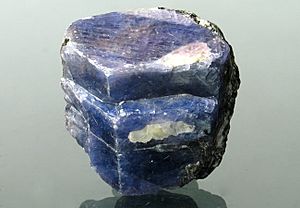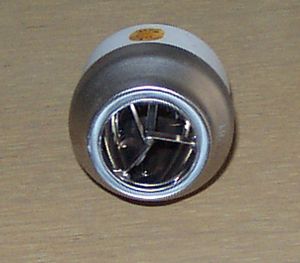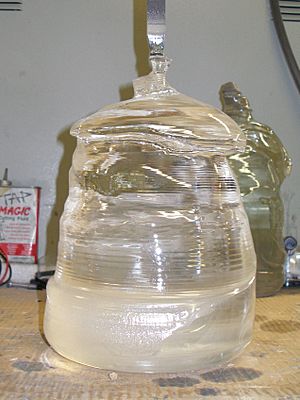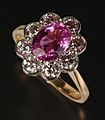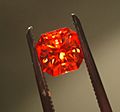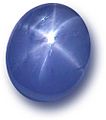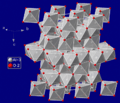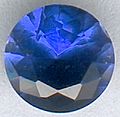Sapphire facts for kids
Quick facts for kids Sapphire |
|
|---|---|
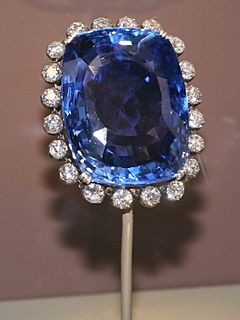
The 422.99-carat Logan sapphire
|
|
| General | |
| Category | Oxide mineral |
| Formula (repeating unit) |
aluminium oxide, Al2O3 |
| Identification | |
| Color | Every color except for red – which is called a ruby – or pinkish-orange (the padparadscha) |
| Crystal habit | massive and granular |
| Crystal system | Trigonal Symbol (32/m) Space Group: R3c |
| Cleavage | none |
| Fracture | conchoidal, splintery |
| Mohs scale hardness | 9.0 |
| Luster | vitreous |
| Streak | white |
| Specific gravity | 3.95–4.03 |
| Optical properties | Abbe number 72.2 |
| Refractive index | nω=1.768–1.772 nε=1.760–1.763, Birefringence 0.008 |
| Pleochroism | Strong |
| Melting point | 2030–2050 °C |
| Fusibility | infusible |
| Solubility | Insoluble |
| Other characteristics | coefficient of thermal expansion (5.0–6.6)×10−6/K |
Sapphire is a beautiful and valuable gemstone. It is a type of mineral called corundum, which is made of aluminium oxide (Al2O3). Sapphires are very similar to rubies, but rubies are always red, while sapphires are any other color.
Most people think of blue when they hear "sapphire." However, sapphires can be many different colors, like amber, orange, yellow, pink, green, and even colorless.
Sapphires have a long and interesting history. Ancient stories say that the tablets of the Ten Commandments were made of sapphire because they were so strong. The ancient people of Persia believed the Earth rested on a giant sapphire, and that's why the sky looked blue.
For a long time, kings and queens have used sapphires. They saw them as a sign of good luck, wisdom, and holiness. For example, Princess Diana and Princess Anne both received sapphire engagement rings. The British Crown Jewels also have many large blue sapphires.
Sapphires are the birthstone for September. They are said to symbolize telling the truth and keeping your promises.
Contents
What Makes Sapphire Special?
Sapphire is one of the hardest minerals on Earth. On the Mohs scale of mineral hardness, sapphire scores a 9. Only diamonds and moissanite are harder. Because it is so hard, sapphire is sometimes used as a tool for polishing other materials.
This mineral is found in special places called "gem gravel deposits." These deposits are formed by heat from metamorphic or igneous plateaus. The main places where sapphire is found are Myanmar, Thailand, India, and Sri Lanka. The most expensive and beautiful sapphires often come from Kashmir, India. More recently, sapphires have also been found in Australia, Kenya, and Tanzania.
Scientists can also grow sapphires in a lab! The first mineral grown in a lab was sapphire, using a method called "flame fusion." Another method, called "flux growth," is also used to create lab-grown sapphires.
Did you know that heating sapphires can change their color? If you heat yellow, light yellow, or colorless sapphires to very high temperatures (1500-1900°C), they can turn dark yellow, gold, golden brown, orange, or reddish brown.
There's also a special kind of sapphire called a "Star Sapphire." These have tiny white needle-like pieces inside them, sometimes called "silk." These tiny pieces create a star-like pattern when light hits the stone. Star sapphires can be heated to remove their blue color, and then heated again to bring the blue color back and remove the white silk.
Where Are Sapphires Found?
Sapphires are dug up from alluvial deposits, which are like riverbeds, or from mines deep underground. Many countries mine sapphires and rubies. These include Afghanistan, Australia, Myanmar (Burma), Cambodia, China, Colombia, India, Kenya, Laos, Madagascar, Malawi, Nepal, Nigeria, Pakistan, Sri Lanka, Tajikistan, Tanzania, Thailand, the United States, and Vietnam.
Sapphires from different places can look a bit different. They might have different tiny bits of other chemicals or microscopic things inside them. This helps experts tell where a sapphire came from.
Some sapphires are more valuable than others. For example, classic sapphires from Kashmir, Burma, or Sri Lanka that haven't been heat-treated are very popular.
Some famous sapphires come from Sri Lanka, like the Logan sapphire, the Star of India, The Star of Adam, and the Star of Bombay. As of 2007, Madagascar was the world's biggest producer of sapphires, especially from an area around the town of Ilakaka. Before that, Australia was the largest producer.
In North America, sapphires have been mined in Montana. You can find them near the Missouri River close to Helena, Montana, and in other areas like Dry Cottonwood Creek and Rock Creek. Fine blue Yogo sapphires are found at Yogo Gulch. Some gem-quality sapphires and rubies have also been found in Franklin, North Carolina.
The sapphire mines in Kashmir, India, are very famous in the gem world. Even though they produced most of their sapphires a long time ago, in the late 1800s and early 1900s, these sapphires are known for their amazing vivid blue color. Some people describe it as a "blue velvet" look. Sapphires from Kashmir are very valuable and can often be recognized by their silky look and special color. This unique blue shines brightly in any light, unlike other sapphires that might look purplish or grayish. Kashmir sapphires have sold for record-breaking prices at auctions.
How Sapphires Are Used Today
Sapphire Windows and Screens
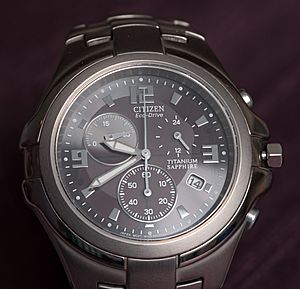
Man-made sapphire, sometimes called sapphire glass, is often used to make windows. This is because it lets light pass through it very well, from UV light to infrared light. It's also incredibly hard to scratch.
The main benefits of sapphire windows are:
- They let a very wide range of light pass through.
- They are much stronger than other clear materials or regular glass.
- They are very resistant to scratches and wear.
- They have a very high melting temperature (2030 °C).
Some sapphire-glass windows are made from large, pure sapphire crystals grown in a lab. These crystals are then sliced into thin pieces and polished until they are very smooth.
Sapphire windows are used in many places. You can find them in high-pressure and vacuum chambers for scientific tests, in watches to protect the face, and in barcode scanners at grocery stores. Their extreme hardness makes them perfect for resisting scratches from daily use.
In 2014, Apple used a lot of the world's sapphire supply for the camera lenses and fingerprint readers on their iPhones. There have also been attempts to use sapphire for smartphone screens because of its toughness. The Kyocera Brigadier was the first smartphone to have a sapphire screen.
Sapphire is also used for the ends of some powerful laser tubes. Its ability to let light through and handle heat means it can work with very strong light without breaking down.
Along with other strong materials, synthetic sapphire is used to make shatter-resistant windows for armored vehicles and some military body armor suits.
Sapphire in Electronics

Thin pieces of sapphire were first used as a base for making integrated circuits, which are tiny electronic chips. This technology is called "silicon on sapphire" or "SOS." Sapphire is a great material for this because it doesn't conduct electricity well, but it does conduct heat well.
"SOS" chips are especially good for high-power radio devices, like those in cell phones, police radios, and satellite communication systems. This technology also allows digital and analog electronic parts to be put together on one chip, and it can create circuits that use very little power.
Large sapphire crystals are grown in labs, then drilled into rods, and thin slices are cut from these rods to make the bases for electronic parts.
Sapphire is also used as a base for growing devices made of gallium nitride (GaN). Using sapphire makes these devices much cheaper. Gallium nitride on sapphire is commonly used in blue light-emitting diodes (LEDs), which you see in many lights and screens.
Sapphire in Lasers
The very first laser was made in 1960 using a man-made ruby rod. Today, Titanium-sapphire lasers are popular. These lasers can be tuned to different colors of light in the red and near-infrared parts of the electromagnetic spectrum. In these lasers, a lab-made sapphire crystal with tiny amounts of chromium or titanium is lit up by a strong lamp or another laser to create a powerful beam of light.
Sapphire in Medicine
Single sapphire crystals are also used in medicine. They are safe to use inside the body. Because sapphire and metal parts rub together with very little wear, sapphire crystals have been used in Ukraine for artificial hip joints.
Sapphire in History and Culture
- The English word "sapphire" comes from old words meaning "blue stone." It might have originally referred to another blue stone called lapis lazuli.
- In ancient Hindu beliefs, wearing a sapphire was thought to make the planet Saturn (Shani) bring good luck to the person.
- In the Middle Ages, people in Europe started calling blue corundum crystals "sapphire," from a Latin word for blue.
- Sapphire is the traditional gift for a 45th wedding anniversary.
- A sapphire jubilee celebrates 65 years. In 2017, Queen Elizabeth II celebrated her sapphire jubilee, marking 65 years since she became queen.
- The sapphire is the birthstone for September.
- An old Italian belief says that sapphires can protect against eye problems and sadness. Mary, Queen of Scots, even had a sapphire pendant that she would rub on her sore eyes.
- Pope Innocent III once said that bishops' rings should be made of pure gold with an unengraved sapphire. He believed the sapphire had special qualities that helped a priest keep secrets.
Famous Sapphires
| Sapphire | Where it Came From | Size | Cut | Color | Where it Is Now |
|---|---|---|---|---|---|
| Bismarck Sapphire | Myanmar | 98.56 carats | Table | Blue | National Museum of Natural History, Washington |
| Black Star of Queensland | Australia, 1938 | 733 carats | Star | Black | Anonymous owner |
| Blue Belle of Asia | Sri Lanka | 392.52 carats | Cushion | Blue | Anonymous owner |
| Logan Sapphire | Sri Lanka | 422.99 carats | Cushion | Blue | National Museum of Natural History, Washington |
| Queen Marie of Romania | Sri Lanka | 478.68 carats | Cushion | Blue | Anonymous owner |
| Star of Adam | Sri Lanka, 2015 | 1404.49 carats | Star | Blue | Anonymous owner |
| Star of Bombay | Sri Lanka | 182 carats | Star | Blue-violet | National Museum of Natural History, Washington |
| Star of India | Sri Lanka | 563.4 carats | Star | Blue-gray | American Museum of Natural History, New York |
| Stuart Sapphire | Sri Lanka | 104 carats | Blue | Tower of London |
Images for kids
See also
 In Spanish: Zafiro para niños
In Spanish: Zafiro para niños


